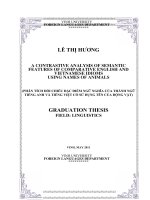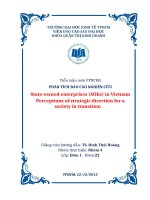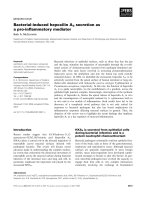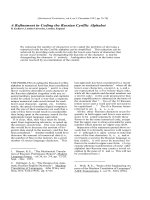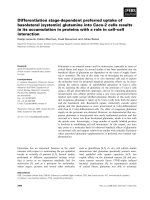Political influence: A culture in university decision-making
Bạn đang xem bản rút gọn của tài liệu. Xem và tải ngay bản đầy đủ của tài liệu tại đây (130.51 KB, 6 trang )
POLITICAL INFLUENCE: A CULTURE IN
UNIVERSITY DECISION-MAKING
Dr. Radhaber D. Khati
GOVERNMENT AND POLITICIANS
Higher educational organization, established, maintained and aided by
the government in socio-economically and educationally least developed country,
have come under the direct secrutiny and supervision of government. It is often
argued that universities, created by Acts passed by the legislature and supported
by government funds, are often financially and politically controlled by the
government. Besides, appointing the chief executive of the university, the
government controls the administrative and decision-making power of the
university. There are some views that support this practice of political control
over the administrative and decision-making affairs of the institutions of higher
education. These views are based on the argument that the organizations with
some type of political control can progress more easily toward the achievement of
their goals (Livingstone, 1974). One of the goals of university officials is the
establishment of a positive relationship between the university and the outside
political world. This relationship, as Livingstone argued, determines the degree of
political control over the universities. He attached political influence in the
decision-making of the university into two sources: political figures and the
government. The former consisting of elected officials, educated politicians and
boards of education, and the latter containing central and local government
bodies. The former has the power and influence to set institutional goals, policies,
and overall guidelines; whereas the latter influences the means and resources of
the institutions (Livingstone, 1974). The power of these political agencies to
influence university decision-making is derived from the public, for they come
from the people they represent. But in the case of Nepal, the elected political
officials assume the control over the central and the local government bodies, and
these bodies are inclined to the political decisions made by the political figures in
the party/ies in power.
Politicians and bureaucrats in the government make policies and laws
with regard to the formation and the proper functioning of the university. The
role of politicians in making university policy decisions has been described by
Baldrige (1971). According to hims, university governance runs more in a
political than collegial or bureaucratic fashion, because the administrators have to
"grapple with the power plays, conflicts, and rough-and-tumble politics." In a
way, similar to what Baldrige described, the politicians, with the help of
bureaucrats and the political-minded educators, make the policies of a university.
His view of the fragmentation of interest groups within a university has relevance
in the context of our university. Different interest groups, within the university
organization, working as faculty, students, and the administrative staff, are often
divided among themselves by their political beliefs and the formal or informal
POLITICAL INFLUENCE: A CULTURE IN UNIVERSITY
affiliations with the respective political parties. These fragmented groups, duly
supported by the respective political parties, form powerful blocks at the
university through which the external power and politics exert influence
(Baldrige, 1971). Therefore, a large portion of the working hours of the chief
executive at the university is spent on compromise and negotiation with these
powerful blocks at the university so that conflicts between administration and the
power blocks could be avoided. It has been noted that the key figure in such an
organization is not the President (or the Vice-chancellor), but the political leaders
either in favor or against the government, who are surrounded by politically
inspired staff, students and the faculty (Baldridge, 1991).
OPPOSING VIEWS
These politicians and the government bureaucrats also have potential
control over the public money and the right to approve or disapprove the budget
of the institution. This type of governmental control, however, is not very
palatable to certain scholars. One of the proponents of the argument against
government control was MacKinnon (1965), who showed his dislike the way
how teachers and educators were removed from making decisions in the affairs of
education, and educational decisions were made by politicians, civil servants, and
various interest groups. MacKinnon believed this was "undemocratic" and would
create great dependency on the part of the institution. Such dependency might kill
institutional initiatives, incentives, and innovations in this type of organization.
However, according to Rudolph and Rudolph (1972), if powers and resources
were put in the hands of local communities that would promote responsibility and
informed decision-making quality in these communities.
In many developing countries, higher education institutions become a
field where politicians play their games of dispute. Conflicting political parties
find it easy to mobilize their own groups of students or teachers at a university in
order to affect their political objectives. In playing these political games at the
university, they try to influence the intellectual sector of the country. It has
further been argued that power by the politicians over the domain of education
means power over the minds, talents, and opinions of the people, and that this is
far more significant than power over their purse, their commerce, or their bodies
(MacKinnon, 1965). Therefore, there is no other area of operation, that
MacKinnon considers to be of great importance for the politicians to exercise
their influence, than education.
There are opposing views regarding political control over and influence
in the decision-making at the university. The argument that political influence in
the decision-making at the university differs from country to country (Karol &
Ginsburg, 1980; Massialas, 1969), and from time to time (Kogan, 1984; Rudolph
& Rudolph, 1972), is not so unconvincing. The direct regulatory control over
higher education institutions by the government was seen by Gore (1982) to be
justifiable. This is one of the ways how larger national society influences the
organization like a university. But, depending on the politics of the country, the
TRIBHUVAN UNIVERSITY JOURNAL, VOL. XXIV, NO. 1, __________
mechanisms to control and influence such organizations differ from place to
place and time to time (Kogan, 1984).
Rudolph and Rudolph (1972), when describing education system and
influence of politics on higher education in neighboring India, stated that the
influence of government on university decision-making was very strong. They
reasoned that my amount of irregularities by the government may be taken as
granted, because it is the responsibility of the government to monitor how the
universities should run. In the context of the countries of our region,
government's role as a facilitator is so closely connected with that of a controller
that one cannot make a clear distinction between the two. In this respect, the
Rudolphs' (1972) view is that if the government ceased to influence or control the
university affairs, the university would become helpless. This would be true
especially in the case of universities that need government support to grow.
ROLE OF CULTURE
The question arises as to whether organizational decisions for the
solutions to the problems in the traditional societies are different from those
decisions that are made for the solutions to the problems in the societies that
appear to be relatively modern. If the decisions are different, is it so due to the
process that differs between any two societies and the cultures? Do social settings
and cultural factors in a country have any impact on the process of decision
making? Hofstede's (1991) analysis with regard to cultural contexts of the
country in relation to decision-making, is quite relevant. He believed that
although "social anthropology" underscores the conviction that all societies,
modern or traditional face the same basic problems, the process of solving
problems differs from country to country. This is because the preference and
process of decision making that are based on specific criteria have different
dimensions in different countries. For Hofstede (1991), the social criteria on
which organizational decision-making is based are concerned with:
(a)
(b)
(c)
(d)
Social inequality, including the employees' relationship with the
authority;
Relationships between individuals and the group;
Concepts of masculinity and femininity; and
Ways of dealing with conflicts.
Of the criteria mentioned above, the most important one that has a
bearing in organizational decision-making is concerned with the subordinate and
higher authority relationship. By constitution, or the law of the country, there
should not be any discrimination among the people and everyone should be
treated equally regardless of caste, class, power, sex, status and wealth. However,
as Hosfstede (1991) said, it is very difficult to find that reality matching the ideal.
The gap between what is ideally prescribed in the constitution or in the book of
law, and what is found to be operating in real practice remains wide in the
countries that are less developed, not only economically and educationally but
POLITICAL INFLUENCE: A CULTURE IN UNIVERSITY
politically. This inconsistency between ideal and the actual practice has a great
bearing on the system of decision-making in an organization.
PERSON, POSITION AND POWER-DISTANCE
With regard to the cultural impact on the decision-making, Hofstede
(1991) noted his concept of power distance. He differentiated big power distance
from small power distance on the basis of the culture of a country. The
organizational structure and the power distance between subordinates and their
boss influence decision-making. There are many supervisory personnel who are
structured into the hierarchy of people reporting to each other. In countries where
the employees are not afraid and the bosses are not often autocratic or
paternalistic, the employees express a preference for a consultative style of
decision making (Hofstede, 1991). Conversely, if the employees are seen as
frequently afraid of disagreeing with their bosses, and the bosses are autocratic or
paternalistic, the subordinates are less likely to approach their bosses and to
contradict them. In a large power distance structure within an organization, the
chances are that the organizational decisions are made or influenced by the
centralized authority holding political power. Nepal falls in the category of large
power distance countries, because the subordinate-boss relationship is not only
characterized by inequality, dependence, and polarization between the tow
groups; but also by obedience and respect from the subordinate, and control from
the superior. Therefore, in the system of administrative decision-making, it is not
always the legitimacy of the decision maker that is gained through one's own
professional expertise, but the power, might, skills, status and wealth of a
superior that enable him to make decisions or influence the decision-making in an
organization.
It has been argued that it is the position rather than the person in it, that
is crucial in exercising power over institutional decision making (MacKinnon,
1965). Even if the positions are held by teachers, the same limitation would apply
to them. Thus, no matter who is in the position, the same human behavior of
exercising power and influence would be exhibited. The decisions that are
appropriate to one institution may not be appropriate to another. This is
particularly so in a complex educational organization like a university where no
issue has a single uniform answer (Karol & Ginsburg, 1980). Therefore, even if
broader higher educational decision making issues are similar among the
universities, certain specifics may be different in the making of decisions from
country to country, depending upon the tradition, culture, and educational levels
of the people at large.
Educational policies seem to have been made in accordance with the
policy and political system of a particular country, as was clearly noted by Cohen
et al. (1974) when he stated, "What you want in the country you put in the
school." Their idea seems to be the basis of political influence on the overall
affairs of higher education and not just on decision making. Politicians' interest in
influencing the decision making of a higher educational Organization appears to
TRIBHUVAN UNIVERSITY JOURNAL, VOL. XXIV, NO. 1, __________
be guided by this basic approach. Similarly, Massialas (1969) mentioned that the
political influence that affects higher education decision-making can easily be
seen when the institution is governed by local authorities. In addition, the
economic, political, and historical contexts of higher education institutions can
also play important roles in influencing the decision-making of higher education.
In the same way, influence on decision-making at the university also
depends upon the organizational structure of the university. If one assumes that
the university is a complex political organization, as Kogan (1984) viewed it, one
would find the greater role of politics to influence decision-making of it. Kogan
conceived of a university, and other institutions of higher education, as intensely
politically complex units, where the line of bureaucratic authority and the line of
political influence merge with each other. Therefore, some universities in some
contexts work like bureaucratic organizations, and some other universities in
some other contexts act like complex political organizations (Birnbaum, 1988). In
Birnbaum's view, external politics, armed with power gained through political
legitimacy, are able to buy desired goods are purchased by the payment of
required amount of money.
The structure of a university Organization is such that the higher-level
decision-making authority is in the hand of a chief executive of the institution. It
is bureaucratic internally, but under great control externally. If one were to
assume administrative features in a bureaucratic structure of higher education
(Birnbaum, 1988), Tribhuvan University administration appears to be tightly
coupled internally and loosely coupled externally.
Bergquist (1992) perceived that political influence or even intervention
on the university decision-making to be something necessary if the government
thinks the decisions and the working procedures of the university are irreparably
damaging, or if the university shows a disregard to the proper norms of its own.
This could be either, for example, in the decisions regarding handling of
university finances, or the appointment and the promotion of faculty, or the
admission of students. Thus, the university organization works more like a
bureaucratic organization than a political one, where central administrative
authority is more powerful and influential. Therefore, even if there is a role of
politics in the decision-making at the university, this role is due to the very nature
of the university itself, which is tightly coupled bureaucratically inside and
loosely coupled to the politics externally (Bergquist, 1992). All this is because,
often times, university creates such an environment by itself where it becomes
convenient or even necessary for outside politics to influence, control, or
intervene in university decisions. Therefore, the university, that teaches every
generation of students how to address the challenges in building the nation, is
now in a position to learn how best it could perform its job in shaping the builder
of a nation.
WORKS CITED
POLITICAL INFLUENCE: A CULTURE IN UNIVERSITY
Baldridge, J.V., & Riley, L.G. (1977). Governing academic organization.
Berkely, CA: McCutchan Publishing Corporation.
Bergquist, H.W. (1992). The four cultures of the academy. San Francisco:
JOssey-Bass.
Birnbaum, R. (1988). How colleges work: The cybernetics of academic
organization and leadership. Boston: Jossey Bass.
Cohen, M..D., & March, J.G. (1974). Leadership and Ambiguity. New York:
McGraw Hill.
Hosfstede Geert (1991). Cultures and Organizations: Software of mind. New
York: McGraw Hill.
Karol, H.N., & Ginsburg, G.S. (1980). Managing the higher education
enterprise. New York: Ronald Press.
Kogan, M. (1984). "The political view." In C.R. Burton (ed.), Perspectives on
higher education. Los Angeles, CA: University of California Press.
Livingstone, H. (1974). The university: An organizational analysis. London:
Blakie & Sons.
MacKinnon, F. (1965). The politics of education: A study of the political
administration of the public schools. Toronto, Canada: University of Toronto
Press.
Massialas, G.B. (1969). Education and the political system. Reading, MA:
Addison-Wesley.
Rudolph, H.S., & Rudolph, I.L. (1972). Education and politics in India.
Cambridge, MA: Harvard University Press.

